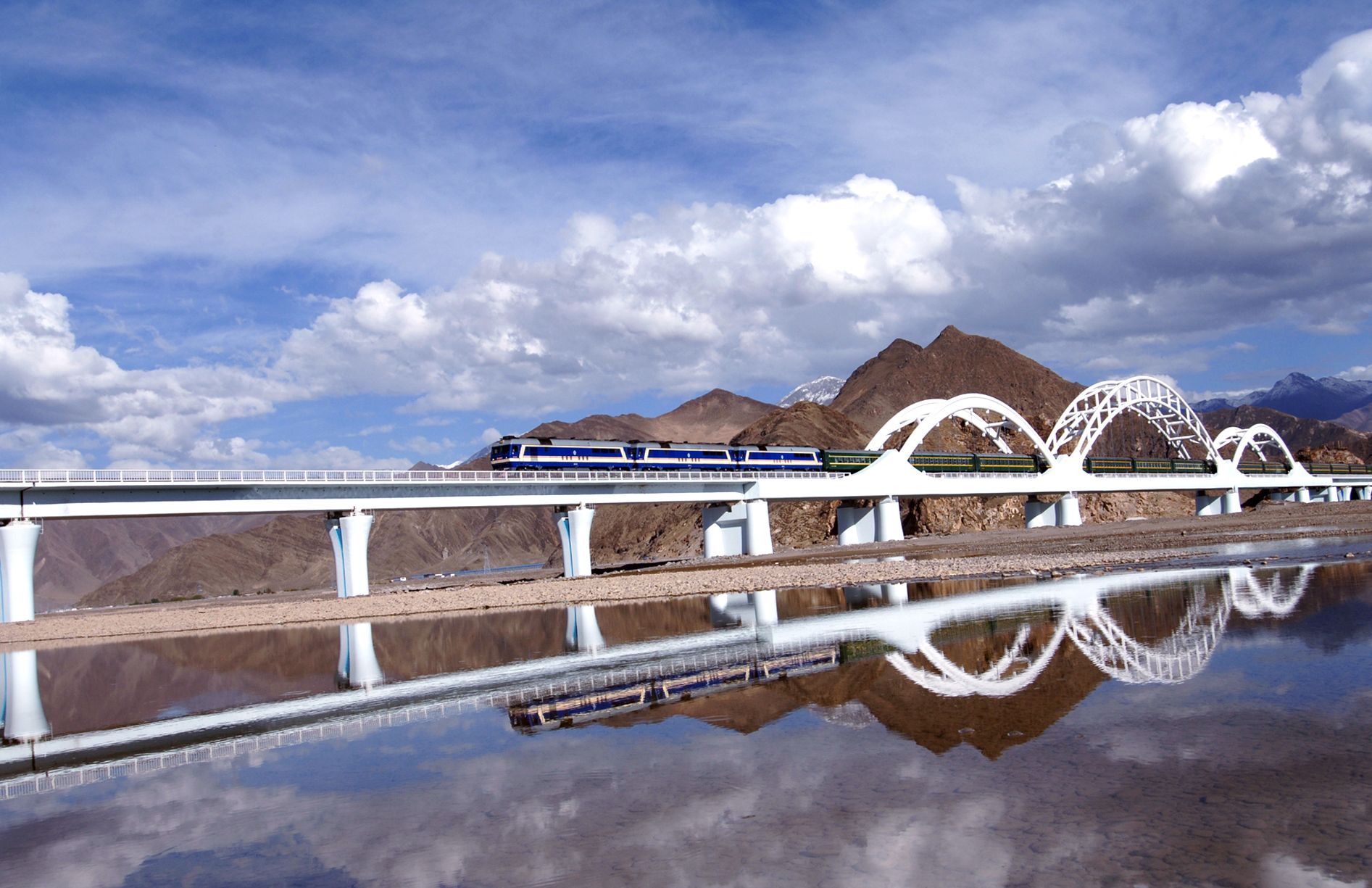

Sie weist mehrere Weltrekorde auf: Mit einem Scheitelpunkt von 5.072 Metern ist sie die höchstgelegene Bahnstrecke der Erde (255 m höher als die Peruanische Zentralbahn),[1] der Neue Guanjiao-Tunnel ist mit 32.600 Metern der längste Eisenbahntunnel des chinesischen Schienennetzes und mit 160 km/h zulässiger Geschwindigkeit gleichzeitig der am schnellsten befahrbare Punkt der Bahnstrecke.[2][3] Die Strecke Xining-Lhasa dauert 2015 ca. 17 Stunden. An ihr liegen ebenfalls der höchstgelegene Bahnhof der Welt (Tanggula, 5.068 m) und der höchstgelegene Tunnel der Welt (4.905 m).[1]
Die Lhasa-Bahn ist eines der größten Eisenbahnbauprojekte, die im 21. Jahrhundert fertiggestellt wurden. Am 15. August 2014 wurde eine 253 km lange Bahnstrecke Lhasa–Xigazê als Verlängerung in die zweitgrößte Stadt Tibets Xigazê in Betrieb genommen.
青蔵鉄道(せいぞうてつどう、読み:チンツァンティエルー)は、中華人民共和国西部の青海省西寧とチベット自治区首府ラサ(拉薩)を結ぶ高原鉄道。総延長1,956kmで青蔵鉄路公司により運営されている。青蔵線とも呼ばれる。日本のメディアでは、青海チベット鉄道と呼ばれることも多い。青海の青と西蔵の蔵から青蔵鉄道と命名された。
西部大開発の代表的なプロジェクトとして、1984年までに一期工事が行われ、2001年からの二期工事を経て2006年7月1日に全通した[1]。建設費は4,500億円と伝えられている。
外国人と台湾人がラサまで乗車する場合は、チベット入域許可書が必要であり、旅行代理店の主催するツアーに参加する必要がある。なお、時期によっては形式上ツアーに参加し、実際には個人旅行として乗車することも可能であるが、シーズンによっては乗車券のほとんどは団体向けに確保されているため、この方法での乗車券の入手はかなり困難である。
建設の目的については、中国によるチベット支配の徹底と民族融合狙いとの報道があった[2]。
The Qinghai–Tibet railway or Qingzang railway (Standard Tibetan: མཚོ་བོད་ལྕགས་ལམ།, mtsho bod lcags lam; simplified Chinese: 青藏铁路; traditional Chinese: 青藏鐵路; pinyin: Qīngzàng Tiělù), is a high-elevation railway that connects Xining, Qinghai Province, to Lhasa, Tibet Autonomous Region of China.
The length of the railway is 1,956 km (1,215 mi). Construction of the 815 km (506 mi) section between Xining and Golmud was completed by 1984. The 1,142 km (710 mi) section between Golmud and Lhasa was inaugurated on 1 July 2006, by Chinese President Hu Jintao: the first two-passenger trains were "Qing 1" (Q1) from Golmud to Lhasa, and "Zang 2" (J2) from Lhasa to Beijing.[1] This railway is the first that connects the Tibet Autonomous Region to any other provinces. Tibet, due to its elevation and terrain, is the last provincial level region in China to have a railway. Testing of the line and equipment started on 1 May 2006.[2] Passenger trains run from Beijing, Chengdu, Chongqing, Guangzhou, Shanghai, Xining, and Lanzhou and can carry between 800 and 1,000 passengers during peak season.[3][4]
The line includes the Tanggula Pass, which, at 5,072 m (16,640 feet) above sea level, is the world's highest point on a railway. Tanggula railway station at 5,068 m (16,627 feet) 33°00′18.50″N 91°38′57.70″E is the world's highest railway station. The 1,338 m (4,390 ft) Fenghuoshan tunnel is the highest rail tunnel in the world at 4,905 m (16,093 ft) above sea level. The 4,010 m (13,160 ft) New Guanjiao Tunnel is the longest tunnel and the culminating point 3,700 metres (12,100 ft)[5] between Xining and Golmud and 3,345 m (10,974 ft). Yangbajing tunnel is the longest tunnel between Golmud and Lhasa. More than 960 km (600 mi), over 80% of the Golmud–Lhasa section, is at an elevation of more than 4,000 m (13,123 ft). There are 675 bridges, totalling 159.88 km (99.34 mi); about 550 km (340 mi) of track is laid on permafrost.
La ligne ferroviaire Qing-Zang (Qing pour Qinghai, Zang pour Tibet)1, ou ligne ferroviaire Qinghai-Tibet, est une ligne de chemin de fer inaugurée le 1er juillet 2006 par le président de la République populaire de Chine, Hu Jintao. Longue de 1 142 km, elle relie la ville de Golmud dans la province du Qinghai (2 800 m d'altitude) à la ville de Lhassa, capitale de la Région autonome du Tibet (3 500 m d'altitude).
C'est la première ligne reliant la région autonome du Tibet au reste de la Chine. Son relief et son altitude en faisaient la dernière région de Chine dépourvue de tout chemin de fer. Le coût de la construction est estimé officiellement à environ 3,5 milliards d'euros. Selon le gouvernement tibétain en exil et différents observateurs, cette ligne pose cependant des problèmes d'ordre politique.
Au 1er juillet 2012, la ligne Qinghai-Tibet a transporté 52,76 millions de voyageurs depuis son entrée en service2.
La linea ferroviaria Pechino-Lhasa, nota anche con il nome di Linea del Qinghai-Tibet, Treno del Cielo o Tibet Express (cinese semplificato: 青藏铁路; cinese tradizionale: 青藏鐵路; pinyin: Qīngzàng Tiělù; tibetano: mtsho bod lcags lam མཚོ་བོད་ལྕགས་ལམ།) è una linea ferroviaria che collega Xining, capitale della provincia cinese del Qinghai, con Lhasa, capitale del Tibet. In tutto la linea serve 44 stazioni e può essere percorsa da otto treni contemporaneamente.
La tratta finale della ferrovia, da Golmud a Lhasa è stata inaugurata il 1º luglio 2006.
El ferrocarril de Qingzang, ferrocarril Qinghai–Xizang, o ferrocarril Qinghai–Tíbet (chino tradicional: 青藏鐵路; chino simplificado: 青藏铁路; pinyin: Qīngzàng Tiělù), es un ferrocarril que conecta Xining, en la provincia de Qinghai, con Lhasa, en la Región Autónoma del Tíbet, en la República Popular China.
Este ferrocarril es el primero en conectar con el resto de China la Región Autónoma del Tíbet, que debido a su altitud y terreno fue la última entidad provincial de China continental sin tener línea de ferrocarril. Existen trenes directos desde Pekín, Chengdu, Chongqing, Xining y Lanzhou, que establecen conexiones entre Lhasa y otras ciudades importantes de China.
La línea incluye el paso de Tanggula, que con 5.072 metros de altura por encima del nivel del mar, lo convierte en la línea de ferrocarril más alta del mundo. También se encuentra el túnel de Fenghuoshan, de 1.388 metros de longitud, que es el túnel de ferrocarril más alto del mundo. El túnel más largo de la línea, el túnel de Yangbajing, mide 3.345 metros; se encuentra a 4.264 metros por encima del nivel del mar, a 80 km al noroeste de Lhasa.
Las primeras pruebas no tripuladas de la línea y su equipamiento comenzaron el 1 de mayo de 2006. La sección del ferrocarril entre Golmud y Lhasa fue inaugurada el 1 de julio de 2006 por el presidente Hu Jintao.











